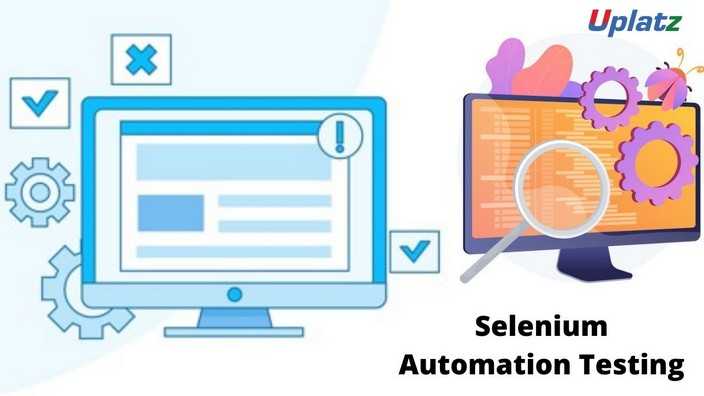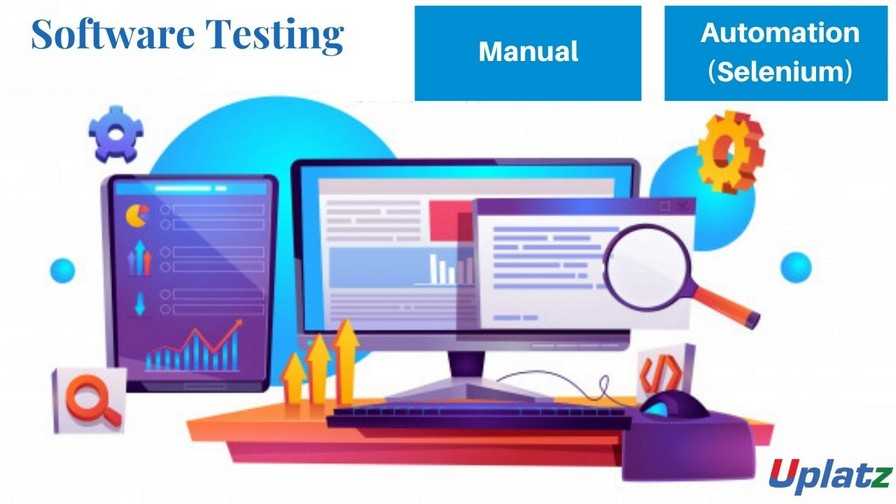Software Testing (Manual Testing)
Learn about exploratory testing, white, black and grey box testing, static and dynamic testing, and functional and non-functional testing.Preview Software Testing (Manual Testing) course
View Course Curriculum Price Match Guarantee Full Lifetime Access Access on any Device Technical Support Secure Checkout Course Completion Certificate 76% Started a new career
BUY THIS COURSE (
76% Started a new career
BUY THIS COURSE (GBP 12 GBP 29 )-
 82% Got a pay increase and promotion
82% Got a pay increase and promotion
Students also bought -
-

- Software Testing (Automation Testing with Selenium)
- 30 Hours
- GBP 12
- 2519 Learners
-

- Software Testing
- 25 Hours
- GBP 12
- 108 Learners
-

- Bundle Combo - Software Testing (Manual and Automation)
- 50 Hours
- GBP 22
- 555 Learners

This Manual Testing course by Uplatz provides the knowledge, skills and understanding of software testing concepts specifically focusing on manual testing process and execution.
Manual Testing, as the name suggests, is a type of software testing where testing is taking out manually without using any automation tools. Manual testing is one of the most initial testing techniques, which is why any application is manually tested before carrying out automation testing. Manual testing allows the testers to find bugs in the software system. Automation testing is a type of software testing wherein automated processes are used for testing. It is transfer out by running test scripts using a tool. Tools such as QTP, Selenium, Test complete etc. are available for automation testing. Every software company needs Quality Testers without whom no software can be released.
This Manual Testing training course will take you through the process of Software Testing, which contains planning, scheduling, test scenarios, error analysis, and so on. It also contains topics like performance testing, regression testing, text execution, preventive measures, generating test reports, and test metrics.
This Manual Testing course will make you expert in performing functional and regression test for software applications and environments through a hands-on approach with real-world examples. The Manual Testing training is designed according to the latest developments as per industry requirements and demands, and learning its content will be essential for clearing the certification exams.
The Manual Testing course is mainly focused on providing maximum exposure to the students and giving them the industry insights into the manual testing industry, to ensure that they are experts in professional manual software testing in different capacities such as exploratory testing, white, black and grey box testing, static and dynamic testing, and functional and non-functional testing.
Course/Topic 1 - Course access through Google Drive
-
Google Drive
-
Google Drive
• Knowledge of quantitative, technical, practical methods that software engineers and developers can use to test their software
• Testing techniques and criteria for all phases of software development - unit (developer) testing, integration testing, system testing, etc.
• Theoretical and practical knowledge of how to apply test criteria to improve the quality of software
• Understanding of best quantitative programming and design practices for ensuring software can be efficiently and effectively modified and tested
• Understanding that maintainability and testability are more important than efficiency for almost all modern software projects
• You will gain an understanding of the theory of testing.
• You will practice writing tests for a variety of quality intent, including code coverage, defect finding, and statistical testing.
• You will develop test plans to guide the testing stage of the software development lifecycle.
SOFTWARE TESTING – MANUAL TESTING – COURSE SYLLABUS
• Software Testing and Principles
• SDLC (Software Development Life Cycle)
• V Model
• Agile Scrum
• Part 1 - STLC - Introduction & Phases
• Part 2 - STLC - Introduction & Phases
• Part 3 - STLC - Introduction & Phases
• Part 1 - Types of Software Testing
• Part 2 - Types of Software Testing
• Functional Testing
• Integration Testing
• Operational Acceptance Testing
• Beta Testing
• Positive & Negative Testing and Testing Techniques
• End-to-end Testing
• Regression Testing and Use of Testing Techniques
• Testing Deliverables and Test Strategy
• Test Plan
• Test Case Development
• Scenario-specific Test Case and Test Metrics
• Requirement Traceability and Bug Report
• Blackbox Testing - part 1
• Blackbox Testing - part 2
• Whitebox Testing
• Mutation Testing
• Penetration Testing Usability and Benchmark Testing
• Manual Testing - Other Topics and Related Questions
• Model Based and Modified Condition Coverage
The Software Testing - Manual Testing Certification ensures you know planning, production and measurement techniques needed to stand out from the competition.
Manual testing is a software testing process in which test cases are executed manually without using any automated tool. All test cases executed by the tester manually according to the end user's perspective. It ensures whether the application is working, as mentioned in the requirement document or not.
Manual testing is the process of testing the software manually to identify the bug, issues and defects in the software product. The aim of a software tester is to break the system and understand the response of the system to various scenarios.
Writing and executing test cases to detect usability and performance issues; conducting exploratory testing – simultaneous test design and execution; verification of multi-device and cross-platform consistency (software works on different devices and browsers)
Uplatz online training guarantees the participants to successfully go through the Software Testing - Manual Testing Certification provided by Uplatz. Uplatz provides appropriate teaching and expertise training to equip the participants for implementing the learnt concepts in an organization.
Course Completion Certificate will be awarded by Uplatz upon successful completion of the Software Testing - Manual Testing online course.
The Software Testing - Manual Testing draws an average salary of $120.000 per year depending on their knowledge and hands-on experience.
Manual testing is a very rewarding career if you know what it means to own your product, and have a macro-vision to see things beyond code — through behaviors. Because manual testers are closest to the users.
But their proficiencies in other areas are very much in demand, given today's collaboration-intensive DevOps and Agile frameworks. Good manual testers are known for their critical thinking and analytical skills.
Note that salaries are generally higher at large companies rather than small ones. Your salary will also differ based on the market you work in.
Manual software tester
Quality Analyst.
Sr, Software tester.
1. 1. What is Software Testing?
Software testing is the act of operating a system or application under control and then assessing their results. It is intentionally simulating a problem situation in order to work out a possible remedy in case a situation like that actually happens.
2. What kind of testing should we consider?
The basic testing to consider include Blackbox testing, Integration testing, Whitebox testing, User acceptance testing, Load testing, Acceptance testing, Performance testing, and Smoke testing.
3. What is Software ‘quality’?
Quality software is software that is reasonably free from bug, is up to the requirements and/or expectations, delivered on time and according to the budget, and is easy to maintain.
4. What is ‘Software Quality Assurance’?
Software Quality Assurance also known as Software QA, encompasses the entire process of developing software: observing and improving the process, seeing that the standards and procedures agreed upon are followed, and making sure that problems are discovered and also fixed.
5. Does every software project need testers?
This solely depends on the context or size of the project, the methodology of development, risks involved, and the experience and skills of the developers. Generally, every project would need testers, except in some cases. A project that is non-trivial sized or with non-trivial risks would need a testing staff. But whereby the project is for a short term, low risk, small, and with programmers that are highly experienced that are making use of test-first development or unit testing, such project may not need a test engineer for it to do well.
6. What is verification? And what is validation?
Verifications are reviews and meetings which are intended to help evaluate documents, code, specifications, and requirements. It is usually done with checklists, walkthroughs, issues lists, and inspection meetings.
Validation, on the other hand, entails the real testing and it is done after completing the verification.
7. What is Regression testing?
This is the act of retesting a program that has been tested previously in order to be sure that there has not been any fault following the modification or that no new fault has been introduced.
8. What is a ‘test plan’? What is a ‘test case’?
A software project test plan is a document that explains the objective, approach, focus, and scope of a software testing. A test case, on the other hand, is a document that explains an action, input, or event, and a response that is expected, to help decide if an application’s feature is functioning properly.
9. Why does software have bugs?
Software has bugs for the following reasons
· Errors in programming
· Lack of communication or no communications at all
· Requirements changes
· Time pressures
10. What should you do after finding a bug?
You need to report the bug and then assign it to developers that can take care of it. When you have fixed the problem, retest the fixes, decide the requirements for regression testing in order to be sure that no more problems are eventually caused by the fixes.
11. How can you introduce new Software QA processes to an existing Organization?
This is usually determined by the organization’s size as well as the risks involved. If it is a small project or group, it may be better to use a more ad-hoc process, depending on the customer and project type. It can also be done via incremental self-managed team approaches.
12. What are 5 common problems in the software development process?
· Schedule that is unworkable
· Requirements changes
· Inadequate communication
· Insufficient testing
· Poor requirements
13. What are the 5 common software development problems solutions?
· Schedule that is practicable
· Clear communication among the project team members
· Firm requirements
· Clearness of requirements
· Sufficient testing
14. What steps are needed in developing and running software test?
· Get the requirements, functional design, and plan for the internal design, and other documents that are relevant.
· Get budget and the schedule conditions
· Decide project framework
· Recognize risks
· Decide testing approaches, process, test setting, test data
· Carry out test
· Carry out reviews and evaluations
· Sustain and keep documents up to date
15. What is the best software test estimation approach?
This is determined by the organization, the type of project, and the experience of the involved personnel. However, here are a few approaches to consider:
· Metrics-Based Approach
· Implicit Risk Approach
· Percentage-of-Development Approach
· Test Work Breakdown Approach
· Iterative Approach
16. How does a client/server environment affect testing?
Client/server applications are sometimes complex as a result of the multiple dependencies among clients, communication of data, server, and hardware, particularly multi-tier systems. Stress/load/performance testing can help to determine the capabilities and limitations of client/server application.
17. What are the attributes of a good software QA engineer?
They should be able to comprehend the whole process of software development and how it blends with the organization’s goal and the business approach. Diplomacy and patience are highly required in the early phases of QA processes implementation. For inspections and reviews to be successful, ability to identify problems and spot ‘what is missing’ is a must.
18. What information does a test strategy capture?
It captures the general approach’s explanation to be used as well as the testing styles, specific types, and techniques.
19. How can we test World Wide Web sites?
Things to consider might include:
· Testing the HTML specification, internal and external links
· Testing the server’s expected loads
· Testing the securities needed to be implemented and verified
· The applets, ActiveX components, cgi programs, javascript, etc that you need to track, maintain, and control
· Performance that you should anticipate on the side of the client.
20. What is extreme programming and what has it got to do with testing?
Extreme programming otherwise known as ‘XP’ is a software development step taken by small teams working on projects that are susceptible to risk and also have requirements that are not steady. To carry out extreme testing, it is expected that the programmers should first write unit and functional test codes before the application code is written. It is also important to make the customer an important part of the project team and assist in developing scenarios that would enable you to conduct acceptance/black box testing.
21. What is ‘good code’? What is ‘good design’?
‘Good code’ is a code that works well, has no bug, can be read, and can be maintained. Good internal design signifies a software code with a clear, understandable, modifiable, and maintainable overall structure. It has to be robust with the capacity for adequate error handling and status logging and works properly when it is executed. Good functional design refers to an application with a functionality that one can trace back to the requirements of the end-user and customers.
22. How can you know when to stop testing?
The following factors determine when to stop testing:
· Deadlines such as testing deadlines, release deadlines, etc are met
· Test cases are completed with ‘pass’ in certain percentage
· Exhaustion of test budget
· Coverage of code/requirements/functionality attains a specified point
· A drop in the rate of bug below a certain level
· An end of the beta or alpha testing phase
23. What if there is not enough time for detailed testing?
· Decide where to focus the testing with the help of risk analysis
· Decide which important functionality is to be tested
· Establish the aspects of the project that are high-risk
· The kinds of test to be performed have to be prioritized
· The tests to have the best high-risk-coverage to time-required ratio have to be decided.
24. What is the main objective when reviewing a software deliverable?
To discover fault in any software work product
25. What determines the level of risk?
The level of risk is determined by the likelihood of an adverse event and the impact of the event
26. What is the benefit of test independence?
It prevents the partiality of the author in defining effective tests.
27. What is SEI? CMM? CMMI? ISO? Will it help?
They are all standards that decide effectiveness in quality software delivery. They help organizations in identifying best practices that are valuable in assisting them in increasing the maturity of their processes.
28. What is integration testing?
This is the testing carried out to be sure of the accurate operation of the components in the implementation model when combined to execute a use case.
29. What is developer testing?
Developer testing refers to the aspect of test design and implementation that the team of developers considers most appropriate to undertake.
30. What is system testing?
It is the series of tests aimed at making sure that the modified program is able to interact properly with other components of the system.









